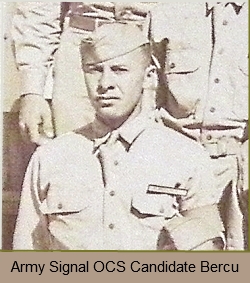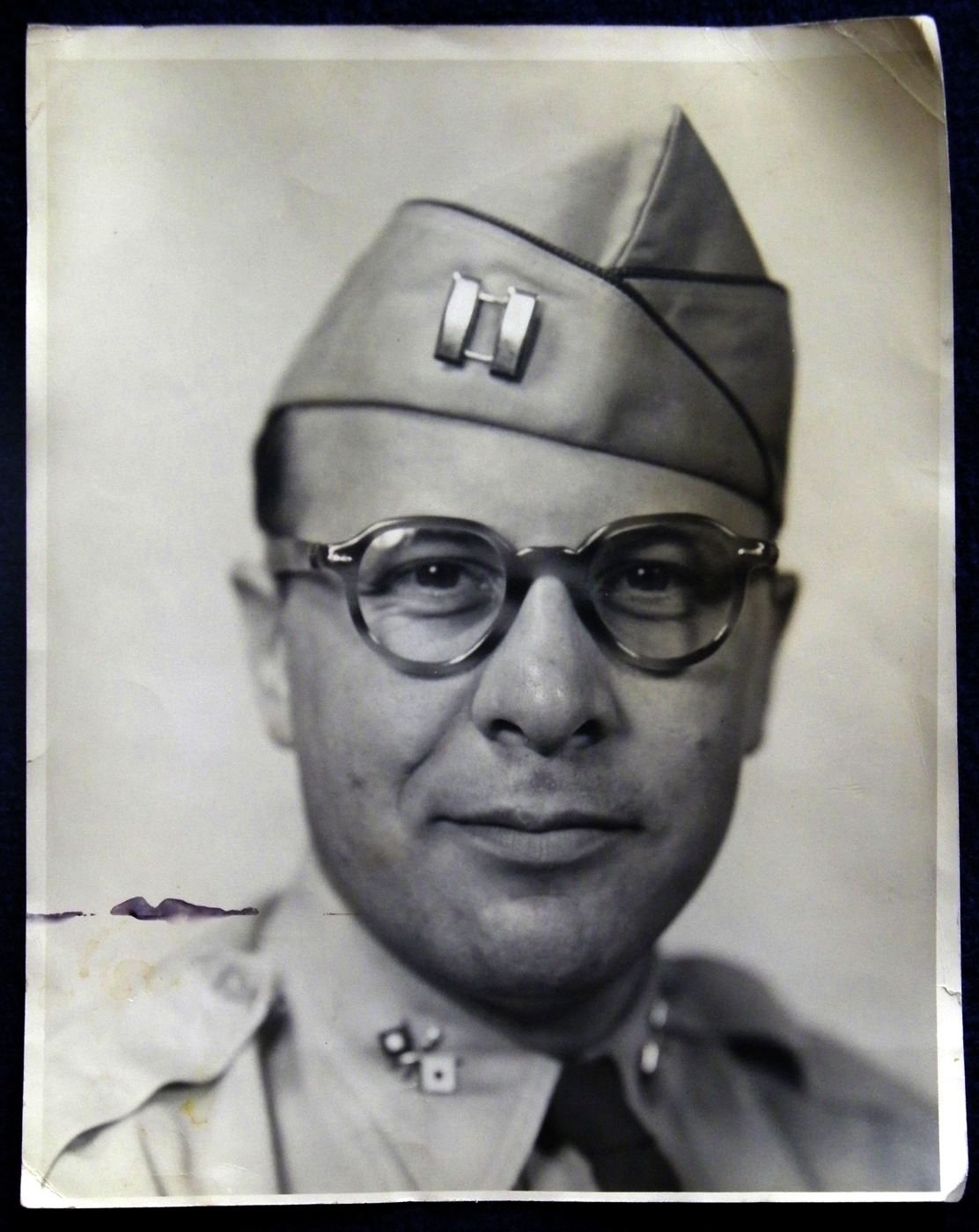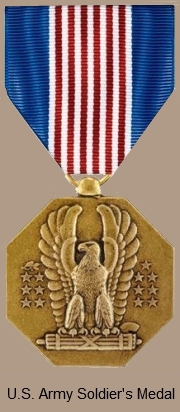This mini-bio was submitted by Candidate Harold Bercu's daughter, Julie. Julie
commented in her letter to the Association that her father was an
entrepreneur and had several successful businesses during his lifetime,
and most importantly, he had a wonderful sense of humor. To this day
Julie's friends still quote what they all call "Bob-isms".
Harold “Bob” Bercu WW II Memoirs (Taken at age 92)
 I
was drafted while living in St. Louis, but I'm not sure of my age. They
sent me to a camp near St. Louis. They asked anyone who could type to
step forward. I stepped forward, because I could type at 90 words per
minute. They had me type up the cards for the men coming in. I did that
for several weeks, and then they assigned me to the Signal Corps.
I
was drafted while living in St. Louis, but I'm not sure of my age. They
sent me to a camp near St. Louis. They asked anyone who could type to
step forward. I stepped forward, because I could type at 90 words per
minute. They had me type up the cards for the men coming in. I did that
for several weeks, and then they assigned me to the Signal Corps.
From there I went to Ft. Monmouth, NJ. I had just been there a short
time, when they called my name out to report to the company office, and
I was told I would be going on a top secret mission. The mission was to
guard a box car load of radar equipment being shipped from Ft. Monmouth
to the west coast. During that trip, I became friendly with the
lieutenant in charge of us. We lived in the caboose, and guarded the box
car load, being careful not to let the car be bumped in the switch
yards, until we got to California.
I was reassigned from California to a new camp, called Camp Crowder, in
Missouri, and was promoted to corporal. I was teaching handling the
rifle, marching in formation, and such to the new recruits. One day when
I had a column of recruits out jogging, one recruit said “It's easy for
you. You don't have a heavy pack like we do.” So I said “Here, I'll
switch with you”. When we did, his knees buckled because I had about 50
pounds in the pack.
The lieutenant I became friendly with was also assigned there. He
encouraged me to apply to officer's school back at Fort Monmouth. I
applied and was accepted into the Signal Corps Officer Candidate School.
 The
school was highly condensed into 90 days, so we were called 90-day
wonders. I was very conscientious and graduated at the head of my class
as a second lieutenant. From Ft. Monmouth, I was assigned to a training
camp in California where I taught pole line construction and
installation of telephone and telegraph lines. As a pole line
instructor, I taught men how to climb wooden poles using strap on spikes
and a belt around the pole. I had become very adept at running up & down
poles.
The
school was highly condensed into 90 days, so we were called 90-day
wonders. I was very conscientious and graduated at the head of my class
as a second lieutenant. From Ft. Monmouth, I was assigned to a training
camp in California where I taught pole line construction and
installation of telephone and telegraph lines. As a pole line
instructor, I taught men how to climb wooden poles using strap on spikes
and a belt around the pole. I had become very adept at running up & down
poles.
As the war progressed, I was transferred to Oahu, HI, and assigned as
commanding officer for a group of Signal Corps technicians. From Hawaii,
we went aboard a ship, and opened our orders at sea. We found we were
going to Tinian in the Marianas Islands. We had no idea where it was,
but we knew we would be somewhere out in the Pacific. We heard there
were still Japanese troops hiding on the island, even though it was only
4 by 8 miles.
When we arrived we had to climb down nets into small boats which took us
to shore. There we set up a camp for the unit, which had about 50 men.
The men I commanded were all repairmen and could fix Signal Corps and
other Army equipment. This was called the Signal Supply Depot. There
were thousands of parts and supplies. So we were called on to fix gear,
and issue equipment that the Signal Corps had. This included equipment
and supplies that were shipped to the wrong place, such as enormous
spools of wire. I was on Tinian for about 2 years. At one point a
wrecked double-ender washed up on shore. We rigged a mast & a boom for
it. Some of the guys could sail and taught us some things, and I was
able to teach them a bit. Another time we were out looking for sea
shells, and a guy got into deep water and started flailing around. I
went in and pulled him out. Someone turned in my name, and I later
received the Soldier's Medal for saving his life. Another time, 6
Japanese soldiers jumped out of the bushes and surrendered to me.
 One
of our most important pieces of equipment was the “sigaba”, which was an
encryption/decryption device, which was guarded at all times. By this
time, all the Japanese had been cleared out, and the fighting forces had
moved on to Iwo Jima. Somewhere in that time I was promoted to first
lieutenant. I returned the “sigaba” to Hawaii. It was chained to me on
the ship along with guards.
One
of our most important pieces of equipment was the “sigaba”, which was an
encryption/decryption device, which was guarded at all times. By this
time, all the Japanese had been cleared out, and the fighting forces had
moved on to Iwo Jima. Somewhere in that time I was promoted to first
lieutenant. I returned the “sigaba” to Hawaii. It was chained to me on
the ship along with guards.
While I was on Tinian, the atomic bomb was delivered there on the
Indianapolis. It was from that air strip that Paul Tibbets dropped it on
Hiroshima in the Enola Gay. We knew it was a big bomb, but had no idea
how powerful it was.
After the atomic bombs ended the war, I was reassigned to Los Angeles,
and left the army there after having been promoted to captain.
When the Korean War broke out, as a captain in the reserves, I was
reactivated. By that time, I was married with 2 children, and we were
expecting our 3rd. I was a salesman for a printing firm in Los Angeles.
The army first sent me to a camp commanded by an officer who had
employed most of the men in civilian life. I was not happy with the very
little they had me doing, so I contacted the head of the Signal Corps
about it. I was promptly transferred to Fort Bragg, NC.
At Fort Bragg, one of my duties was to find out why, when men jumped
from B29s, and some other aircraft, the T7 parachute would snag
something on the plane. Men were getting broken shoulders, and worse. I
went up many times in a fighter plane to photograph the B29 as men were
jumping out from all angles. As a result of that the chute design was
changed. (At the time I was also an amateur photographer.)
At the end of the war I was discharged into civilian life.


